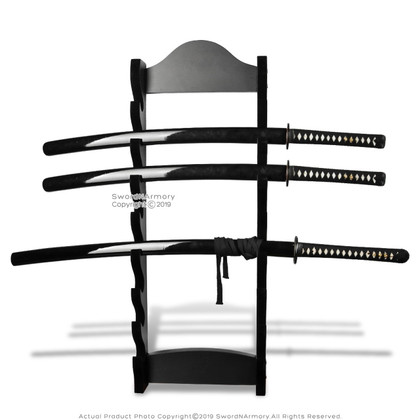3 Main Differences Between Functional and Display Swords
Posted by Sword N Armory on Feb 29th 2020
There are swords built for contact against other swords or cutting other objects, and there are swords built specifically to hang on the wall. Decorative swords are not made of a flexible material, nor are they constructed in a way that will tolerate a strike against another object. Using a decorative sword against another sword can be dangerous, so it's important to consider the following factors before using any sword as a weapon.
Difference #1: Most decorative swords are made of stainless steel. Stainless steel is highly corrosion resistant, so your decorative sword will look beautiful and last for several years. However, stainless is a poor choice for a weapon because it is rigid and brittle. The risk of breakage is great and this can result in injury.
Stainless steel is cast from a mold, rather than formed. It is an alloy of steel and chromium, which keeps it shiny and prevents rust. However, under stress, stainless can break or shatter.
Difference #2: The "tang" or piece of metal that extends from the blade up into the handle is critical to the strength of the blade. Most decorative blades are built with a stick or rat-tail tang, a narrow piece of metal that threads through the pommel into the handle to make it possible to grasp and swing the blade. A decorative blade, when swung against another blade, will likely break at the handle because of the relative weakness of the tang.
Functional swords generally feature a tang that is nearly as wide as the blade and either as long as or 3/4 as long as the handle. The tang of a functional blade is often hot peened to the handle. By this process, the portion of the tang that extends past the end of the handle is heated and hammered until it compresses down into the handle, similar to a rounded nail head. This secures the handle to the blade and makes it one solid unit, ready for the stress of striking against another blade.
Difference #3: The forging process of a functional sword accomplishes several things. First of all, it aligns the grain of the steel so the metal will flex rather than shattering. Forged steel is forced steel, or steel that has been forcefully manipulated from a block of metal into a workable sword. It hasn’t been hardened with other metals or brightened with chromium, so it’ll rust if not properly cared for.
Final Sword Thoughts
A well-forged sword contains one long piece of steel from striking tip to the end of the handle. The hilt consists of three facets. The cross guard separates the blade from the handle and functions to protect the users hands and add weight to balance the length of the blade. The handle needs to provide plenty of comfortable and secure grip space for the user to grasp and swing the sword in confidence. The pommel is the portion of the sword closest to the user. Within the pommel, the tang is secured to the entire sword functions smoothly and snugly. Any poorly made connections in the hilt will cause the sword to rattle and be jarring to the user.
A forged sword is a weapon with stamina and flexibility. While it may look nice on the wall, it can be put to other uses. A decorative sword is a cast piece of stainless steel with rudimentary contacts between blade, hilt and user. It’s meant to be admired, not used.












